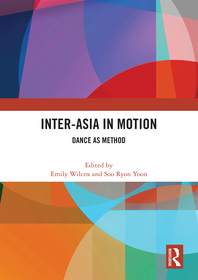
Inter-Asia in Motion
Dance as Method
- Publisher's listprice GBP 42.99
-
20 538 Ft (19 560 Ft + 5% VAT)
The price is estimated because at the time of ordering we do not know what conversion rates will apply to HUF / product currency when the book arrives. In case HUF is weaker, the price increases slightly, in case HUF is stronger, the price goes lower slightly.
- Discount 10% (cc. 2 054 Ft off)
- Discounted price 18 484 Ft (17 604 Ft + 5% VAT)
Subcribe now and take benefit of a favourable price.
Subscribe
20 538 Ft

Availability
Estimated delivery time: In stock at the publisher, but not at Prospero's office. Delivery time approx. 3-5 weeks.
Not in stock at Prospero.
Why don't you give exact delivery time?
Delivery time is estimated on our previous experiences. We give estimations only, because we order from outside Hungary, and the delivery time mainly depends on how quickly the publisher supplies the book. Faster or slower deliveries both happen, but we do our best to supply as quickly as possible.
Product details:
- Edition number 1
- Publisher Routledge
- Date of Publication 29 August 2025
- ISBN 9781032561608
- Binding Paperback
- No. of pages232 pages
- Size 246x174 mm
- Weight 430 g
- Language English 691
Categories
Short description:
This book explores dance and choreography as sites for the articulation of new theoretical and historical paradigms in inter-Asia cultural studies. It covers a range of dance works, artists, genres, and media, from Kathak to K-pop flash mob dance, Cold War diplomacy to avant-garde dance collaborations, and festival dance to dance on screen.
MoreLong description:
This book explores dance and choreography as sites for the articulation of new theoretical and historical paradigms in inter-Asia cultural studies.
The chapters in this volume cover a wide range of dance works, artists, genres, and media, from Kathak to K-pop flash mob dance, from Cold War diplomacy to avant-garde dance collaborations, and from festival dance to dance on screen. Working against the Western-centric category of “Asian dance” and Western-centric theorizations of intercultural performance that foreground “East-West” relationships, each contribution shows how dances in Asia make one another as their key aesthetic references beyond Eurocentric influences, as well as how inter-Asia relations emerge from cultural, geographical, and aesthetic diversity within the region. This book is the first of its kind in both cultural studies and dance studies. It will contribute greatly to readers’ understanding of how performance shapes and transforms the cultural and political dynamics of inter-Asia, with a focus on dance circulations in and across East, South, and Southeast Asia.
Inter-Asia in Motion: Dance as Method will be a key resource for academics, researchers, and advanced students of Dance Studies, Performance Studies, Cultural Studies, Asian Studies, International Relations and Politics, History, and Sociology. The chapters included in this book were originally published in Inter-Asia Cultural Studies.
MoreTable of Contents:
Introduction 1. “Gangnam Style” in Dhaka and inter-Asian refraction 2. Performing Bandung: China’s dance diplomacy with India, Indonesia, and Burma, 1953–1962 3. Choreographing neutrality: dance in Cambodia’s Cold War diplomacy in Asia, 1953–1970 4. Geographies of the classical: Kathak across India and Hong Kong 5. Inter-Asian dance as method, artistic research as method: Nam Hwayeon’s work on Choi Seung-hee 6. The aesthetics of intercultural method: from process to procession in new Indonesian and Indo-Australian dance 7. Bharatanatyam and Buddhist diplomacy: inter-Asia significations in Santha Bhaskar’s Anweshana: The Search for Nalanda 8. “The nightingale is a graceful dancer”: Bulbul Chowdhury, dance heritage, and the new nation-state of Pakistan 9. Dancers in the Japanese entertainment troupe of comfort in the 1940s: traveling along the Burma–China frontline 10. Dancing me from South to South: on Wu-Kang Chen and Pichet Klunchun’s intercultural performance 11. Japanese dancers, Bollywood dance: finding authenticity at Tokyo’s Namaste India Festival 12. Multicultural dance-making in Singapore: Merdeka, youth solidarity and cross-ethnicity, 1955–1980s
More



